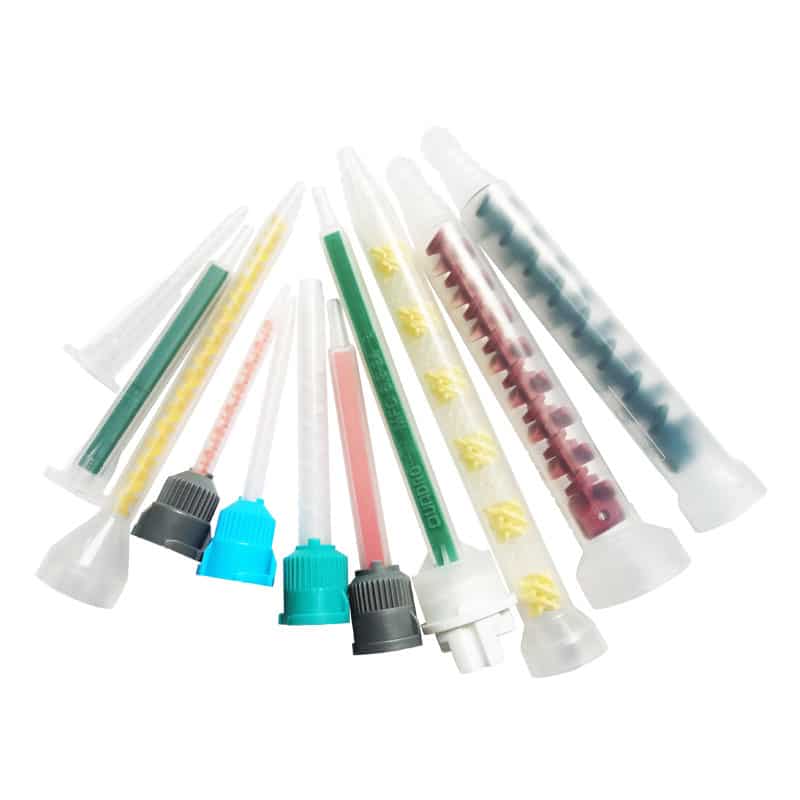Precision and efficiency are essential factors when it comes to mixing substances in various industries. Epoxy mixing nozzles and dental mixing tips are two commonly used tools that facilitate the blending process. Although they may appear similar at first glance, these tools are designed for distinct applications. In this article, we will delve into the similarities and differences between epoxy mixing nozzles and dental mixing tips, shedding light on their specific functions, features, and advantages.
Epoxy Mixing Nozzles:
Epoxy mixing nozzles are primarily used in construction, manufacturing, and DIY projects that involve bonding materials. These nozzles are typically utilized in conjunction with dual-component epoxy cartridges or syringes, providing a convenient and efficient way to mix and dispense epoxy compounds.
Design and Construction:
Epoxy mixing nozzles are usually made of durable plastic, featuring a tubular shape with a threaded connection on one end for attachment to the epoxy cartridge. The opposite end of the nozzle consists of a static mixing element, which plays a critical role in combining the epoxy components during the dispensing process.
Mixing Mechanism:
The mixing mechanism in epoxy mixing nozzles involves the intersecting flow of the two epoxy components. As the substances pass through the static mixing element, they are effectively blended together, ensuring a thorough and homogenous mixture. The mixing element within the nozzle is designed to create turbulence and promote efficient blending, eliminating the need for manual mixing.
Disposable Nature:
Epoxy mixing nozzles are typically disposable, meaning they are intended for single-use applications. This disposable feature helps prevent cross-contamination between different epoxy mixes and ensures consistent mixing results. After each use, the nozzle is discarded and replaced with a fresh one, maintaining hygiene and preventing potential contamination.
Dental Mixing Tips:
Dental mixing tips, as the name suggests, are specifically designed for use in the field of dentistry. These tips play a crucial role in the preparation and mixing of dental materials, such as impression materials, cements, and composite resins, ensuring accurate proportions and a homogenous blend.
Structure and Design:
Dental mixing tips are typically made of durable plastic and consist of two chambers or barrels. Each barrel is dedicated to holding a separate component of the dental material to be mixed. The tips have a unique helical design, which enables the efficient combination of the two components during the extrusion process.
Mixing Mechanism:
Dental mixing tips rely on a dynamic mixing mechanism. As the dental material is extruded from the barrels, it is forced through helical channels within the tip. The interaction between the two components occurs through the shearing and kneading action induced by the helical design. This ensures thorough mixing and homogeneity, crucial for obtaining accurate dental impressions and achieving optimal bonding strength.
Sterilization and Reusability:
In dental practices, maintaining a sterile environment is paramount. Dental mixing tips are usually designed for single-use applications to minimize the risk of contamination. After each use, the tips are discarded to ensure a clean and safe environment for patients. However, there are some models available that are designed for reusability. These reusable tips can be sterilized between uses, allowing for cost savings and reduced waste, while still ensuring proper infection control practices.
Similarities:
-
Mixing Function:
Both epoxy mixing nozzles and dental mixing tips share the primary purpose of achieving a thorough mixture of multiple components. They both enable the simultaneous dispensing and blending of two or more substances, ensuring a homogenous mixture.
-
Material:
Both epoxy mixing nozzles and dental mixing tips are typically constructed from durable plastic materials. This choice of material ensures stability, compatibility with various substances, and ease of use.
Differences:
-
Application:
-
Epoxy Mixing Nozzles:
These nozzles find widespread use in construction, manufacturing, and DIY projects that involve bonding materials. They are ideal for mixing epoxy compounds, such as adhesives, sealants, or resins, where precision, strength, and durability are paramount.
-
Dental Mixing Tips:
Designed specifically for the field of dentistry, dental mixing tips are used to prepare and mix dental materials, including impression materials, cements, and composite resins. Their precise mixing capabilities are crucial for achieving accurate dental impressions and ensuring optimal bonding strength.
-
-
Design and Construction:
-
Epoxy Mixing Nozzles:
Epoxy mixing nozzles have a tubular shape with a threaded connection on one end for attachment to epoxy cartridges. They feature a static mixing element at the opposite end, which facilitates the blending process through turbulence and efficient mixing.
-
Dental Mixing Tips:
Dental mixing tips consist of two barrels or chambers, each dedicated to holding a separate component of the dental material. They have a helical design, which facilitates the mixing process through shearing and kneading actions. The helical channels within the tip ensure thorough blending of the components during extrusion.
-
-
Mixing Mechanism:
-
Epoxy Mixing Nozzles:
The mixing mechanism in epoxy mixing nozzles involves the intersecting flow of the two epoxy components. As the substances pass through the static mixing element, they are effectively blended together, ensuring a thorough and homogenous mixture.
-
Dental Mixing Tips:
Dental mixing tips rely on a dynamic mixing mechanism. The dental material is extruded through helical channels within the tip, where the components are sheared and kneaded together. This action ensures the blending of the components and the creation of a homogenous mixture.
-
-
Sterilization and Reusability:
-
Epoxy Mixing Nozzles:
Epoxy mixing nozzles are typically disposable, designed for single-use applications. This eliminates the risk of cross-contamination and ensures consistent mixing results with each use.
-
Dental Mixing Tips:
Dental mixing tips are also often disposable, ensuring a sterile environment in dental practices and minimizing the risk of contamination. However, some models are designed for reusability, allowing for proper sterilization between uses. The choice between disposable and reusable tips depends on specific requirements and infection control practices.
-


